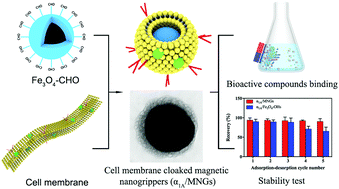A novel cell membrane-cloaked magnetic nanogripper with enhanced stability for drug discovery†
Abstract
Cell membrane-cloaked nanotechnology has attracted increasing attention owing to its unique bionic properties, such as specific recognition and biocompatibility conferred by the integrated membrane structure and receptors. However, this technology is limited by the dissociation of the cell membrane from its carrier. Here, we report a novel type of cell membrane-cloaked modified magnetic nanoparticle with good stability in drug discovery. High α1A-adrenergic receptor (α1A-AR) expressing HEK293 cell membrane-cloaked magnetic nanogrippers (α1A/MNGs) were used as a platform for the specific targeting and binding of α1A-AR antagonists as candidate bioactive compounds from traditional Chinese medicine (TCM). Furthermore, using a dynamic covalent bonding approach, α1A/MNGs showed great stability with positive control drug recoveries of α1A/MNGs showing almost no decline after use in five adsorption–desorption cycles. Moreover, the α1A/MNGs possessed a unilamellar membrane with magnetic features and exhibited good binding capacity and selectivity. Ultimately, TCM and pharmacological studies of the bioactivity of the screened compounds confirmed the considerable targeting and binding capability of α1A/MNGs. Application of aldehyde group modification in this drug-targeting concept further improved biomaterial stability and paves the way for the development of new drug discovery strategies. More importantly, the successful application of α1A/MNGs provides new insights into methodologies to improve the integration of cell membranes with the nanoparticle platform.



 Please wait while we load your content...
Please wait while we load your content...